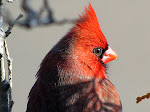On the night of Saturday, June 9th, 2012, I vowed to get up earlier and get to Long Run Park earlier on the following day. The old expression, “The early bird gets the worm,” kept looping in my mind, because there would be a chance of rain by noon, and as the day wears on and more and more humans inhabit the park, the shyer birds leave the area or retreat to more isolated areas.
As stated in
FAVORITE PHOTOS: 120609, there were three species of birds that saw, but did not manage to photograph. Those three species (in order of my degree of desire to get a photograph of them) were a Green Heron, an Indigo Bunting, and a Great Blue Heron. I figured that to even get a chance at the herons, I had to be there with the sunrise.
Well, I did not make there with sunrise, but whereas I took my first shot on Saturday at 10:18AM, on Sunday, I took my first shot at 07:38AM. To my delight, when the day was done, I had gotten photographs of a Green Heron, an Indigo Bunting, and a Great Blue Heron. I was also got gifted by a couple, a nice couple, the male and female of a species I had never seen in real life nor photographed before: Blue Grosbeaks.
The following are my five best quality photographs from June 10th, 2012. As fate would have it, the best quality photograph of the day was not that of a Green Heron, an Indigo Bunting, nor a Great Blue Heron; it was of the little lady pictured immediately below.
1)


3)



From my point of view, the photograph of the Downy Woodpecker is of better picture quality than either of the Green Heron photographs. Granted, I was only twenty feet from the woodpecker, whereas I was over one hundred feet away from the heron.
Just to give you some perspective, I will use my fourth best photograph of the day to show you how the Green Heron looked through my viewfinder as I gradually zoomed in. Keep in mind that the Green Heron was perched on a limb of the straight standing of the two crisscrossed saplings at the right of the Great Blue Heron.
Note also that I am designating following four photographs according to the focal length assigned to each by my editing software, and in no way am I asserting that I actually know what those numbers mean.
Again, I have no real idea as to exactly what those numbers mean. In fact, I find it all somewhat confusing when I consider that may fourth best favorite photograph of the day ( a very close up photograph of the Great Blue Heron) was also assigned a 150.50 millimeter focal length by my editing software, and I know full well that I zoomed in much closer than I did for the photograph directly above.
Be that as it may, the point is such that the Downy Woodpecker photograph turned out better than either of the heron photographs simply because I was much closer to the woodpecker than I was to the herons. Having said that, though, I personally like the Green Heron photographs more than the woodpecker photograph, because I've only seen the Green Heron on one day out of the year in each of the past three springs since I started taking pictures. Below is my best shot of it (or one) from 2010 and my much better photograph of it (or one) from 2011.
Before I started taking pictures of birds, I had never saw nor heard of a Green Heron. Now I look forward to seeing and getting a photograph of this bird every spring.
See one dozen of my other favorite photographs from my June 10th, 2012 birding venture on
FAVORITE PHOTOS: 120610 (continued).























_edited-1.jpg)


















